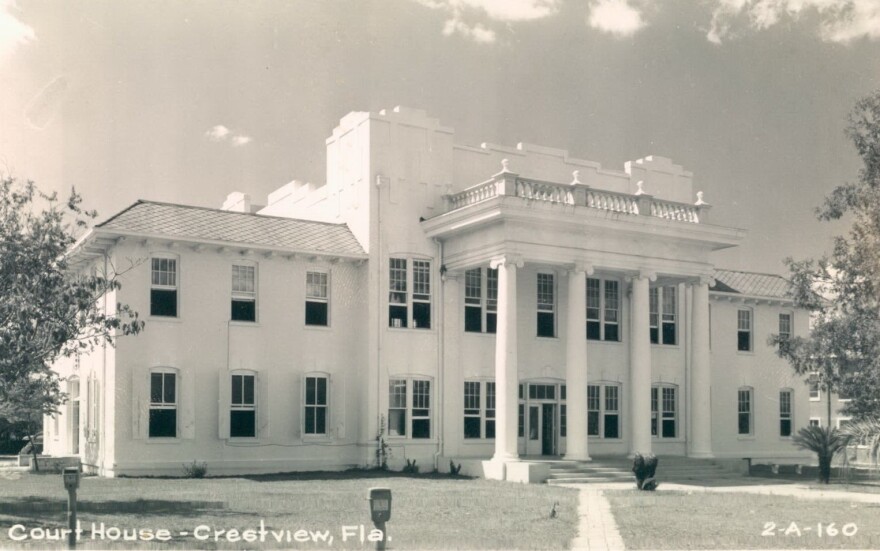Okaloosa County is the 52nd county in the state of Florida and was formed from portions of Santa Rosa and Walton County in 1915. And, this year, Okaloosa County is celebrating its centennial. Several local museums shared their knowledge about the formation of the county and the history of its early years.
When it was established 100 years ago, Okaloosa was sparsely populated with only about 9,000 people. The county was formed out of necessity to conduct business, given the poor transportation access and long distance between Milton, the county seat in Santa Rosa, and the Walton County seat in DeFuniak Springs.
“There was, by the way, no paved roads or anything in the county at that time either, not a mile of paved roads.”
Ann Spann is the Executive Director of the Baker Block Museum in Baker, Fl. Span says the idea to form Okaloosa County came from a local journalist with no political experience, “The gentleman who is known as the “Father of Okaloosa County,” William Henry Mapoles, he was a native of Santa Rosa County in Milton where his father founded the Milton Gazette. He moved to Laurel Hill as a young man and established his own newspaper The Laurel Hill News and he was there at the time he became a State Representative for Walton County. He would go and introduce the bill at the legislature to form Okaloosa County. “
The first legislative push - that started in 1913 - failed. However, after a very spirited campaign, the bill was reintroduced in 1915 and voters from Santa Rosa and Walton favored the formation of the new county.
Span says the next order of business was deciding where the county seat should be located, “Naturally a lot of people thought that Laurel Hill was the right place for the county seat because of the town being incorporated. The four communities, Laurel Hill, Baker, Milligan, and Crestview all wanted the county seat. It came down to an election and there was a runoff between Crestview and Baker. They had received the most votes.”
Crestview won the vote; and in April of 1917, the county seat was permanently moved to Crestview from its temporary location in the flood-prone community of Milligan near the Yellow River.
Located in the center of the county, Crestview was a logical choice, especially because, the city sat along the Old Spanish Trail and the Pensacola & Atlantic Railroad lines, “Crestview had sprung up as a result of the railroad. Many of the towns along the railroad, Milligan was a railroad town and Crestview and had developed with the coming of the railroad in the 1880s.”
Along with the railroad, Spann says timber and turpentine were the major industries.
“Many families migrated through the Carolinas and as the timber and turpentine played out in those areas they moved on south to Georgia and Alabama and then on in to the Florida Panhandle.”
“So, this is our industry on either side of the ramp here. Turpentine being the first and greatest industry for the formation of Okaloosa County.”

While touring the Heritage Museum of Northwest Florida in Valparaiso, Education Coordinator, Crystal Moore walks me through the industry display, pointing out that some of the trees used at the time are still around today, “Turpentining was really interesting because it used the long leaf pine trees, which we have an abundance of. But if it was done properly it would not damage or destroy the tree. And, so many of these trees that have been turpentined we can still find in our parks, forests, or even backyards.”
Moore also talks about the importance of the turpentine itself, which had a multitude of uses - back then, “The pure turpentine and the rosin were both used for a number of things. I think some which were for medicinal purposes which were not a good idea but they didn’t know that at the time. Solvents, disinfectants, soap, printing, ink, varnish, but much of what turpentine and rosin were used for has now been replaced by manmade chemicals and items.”
Other contributing factors to the growth and development of Okaloosa County came later on from the fishing industry and the opening of Eglin Air Force Base after World War II.
The Heritage Museum of Northwest Florida continues to celebrate Okaloosa County’s 100th Anniversary by hosting a public lunch time lecture this Friday, October 9th entitled “Tombstone Tales: Cemeteries, Symbols, and Stories . The guest speaker for the event is UWF Archaeology graduate student Katherine Sims. In addition, the Baker Block Museum hosts its annual Heritage Festival with exhibits and hands on demonstrations on November 7th.

